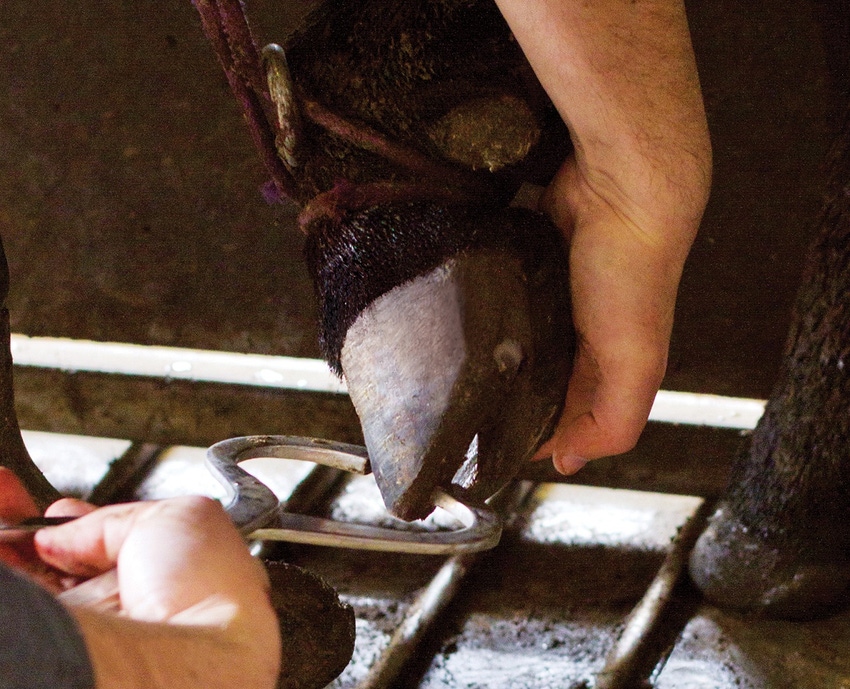Toe abscesses need more attention
Late treatment and lack of treatment for lameness has serious consequences. But that can be improved.

Lameness probably continues to be an undertreated ailment in cattle.
When Dr. Shane Terrell began researching lameness for a PhD project he was hoping to establish some data and maybe some protocols to improve timing and diagnoses of lameness problems.
Historically, feeders tend to pull lame cattle only when they fall behind the rest of the pen, says Dr. Terrell. The problem with that methodology is when you wait so long those primary injuries become secondary injuries such as septic joints.
Dr. Terrell, who is a veterinarian and staff member of Production Animal Consultation at Gothenburg, Nebraska, believes some progress has been made. His initial research was partially funded by Zinpro, which now offers lameness training online and a nifty decision tree previously covered in BEEF Vet. In practice Dr. Terrell has continued his research and has worked with clients to improve early detection and treatment of lameness, which he says is paying dividends.
He believes there is quite a bit of room for improvement across the industry.
Although lameness falls significantly behind respiratory disease and digestive upset as a cause of morbidity and mortality, it is the third cause of health issues in feedlots. It has a cost of $7.26 per head per year across all fed cattle when accounting costs from realizers (crippled discounted cattle) and mortality. His research projects have shown mortality from sole and toe abscesses are at two to four incidences per 10,000 head in feedlots. Among those pulled, mortality runs 2-6%.
In the slow-to-pull and slow-to-treat model of handling lameness, toe and sole abscesses aren't often differentiated from leg injuries because of similarity of pain reaction. The misdiagnosis of abscesses as stifle problems, in fact, continues to be a problem, Dr. Terrell says. To a degree the same things could be said of a lack of differentiation between hairy heel wart (digital dermatitis) and foot rot.
Dr. Terrell says the overall incidence of lameness probably is fairly constant, but as feedlot cowboys receive training the number of pulls tends to increase. Among his clients, at least, more abscesses are being diagnosed, but that may be from better early detection.
Abscesses have four contributing factors, Dr. Terrell says.
Rough or improper processing surfaces
Poor handling
Dehydration
Length of haul
Some concrete surfaces create what Dr. Terrell calls a "slip-and-catch" circumstance, wherein cattle hooves slip on a smooth surface and then catch on a bump. This is common where concrete has been poured and then some kind of tread pattern pressed into the surface, he says. Better is concrete poured and dried, then a diamond pattern cut into the surface to help hold an organic pack substrate in place such as corn stalks, some kind of bedding, or possibly dry manure.
Handling should be slowed down to remove stress from the cattle. Dehydration, such as occurs with long-haul trucking, is a major contributor to abscesses because the first place cattle lose circulation is in their extremities, he says.

Toe abscesses need to be drained as soon as possible, or the infection can move up the leg.
Treatment options
Abscesses need to be drained by nipping off the toe of the damaged hoof for toe abscesses, or the majority of the sole for sole abscesses. Dr. Terrell says he's heard complaints about exposure of the hoof interior to dirt, but he replies that he'll gladly trade some dirt for pus.
When left without drainage, the infection only has two options: Travel up into the leg or leak out at the top of the hoof along the coronary band.
One of the problems with hoof treatment is safe access to feet for the veterinarians and other workers. The only solutions for this are tilt-table cattle chutes or a foot-tie and pulley system to restrain the feet.
Dr. Terrell adds that post-processing in feedyards it is fairly normal to see a slight increase in lameness of perhaps 1-3%, which he attributes to normal "bumps and bruises." If any higher, it's time to evaluate some of the causes in your feedyard.
About the Author(s)
You May Also Like


.png?width=300&auto=webp&quality=80&disable=upscale)
